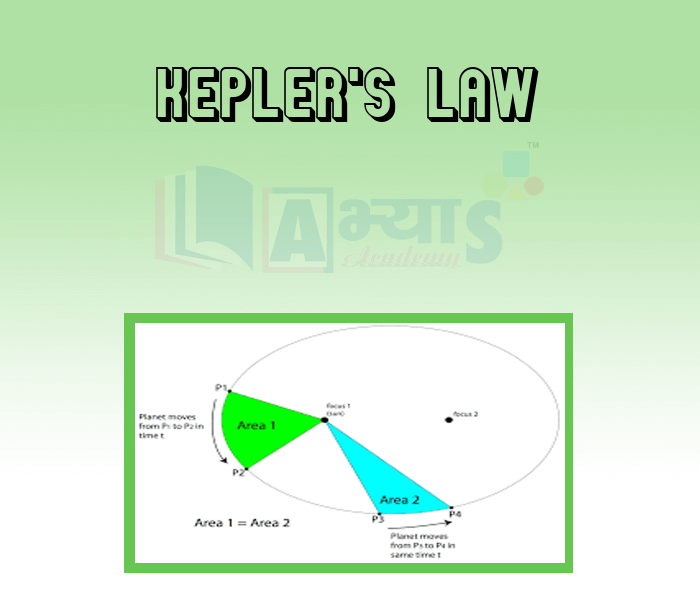Kepler Laws










Kepler Laws
Kepler’s Laws of Planetary Motion:
Johannes Kepler proposed three laws of planetary motion in 16th century. The three laws are given as below:
1. Kepler’s First Law:
It states that the path of any planet in an orbit around the sun follows the shape of an ellipse with the sun at one of its foci. The point in the orbit of a planet nearest to the sun is called perihelion and the point farthest from the sun is called aphelion.
.jpg)
2. Kepler’s Second Law:
It states that an imaginary line from the sun to the planet sweeps out equal areas in equal intervals of time. Thus, if the time of travelling of a planet from P1 to P2 and from P3 to P4 is same, then the areas Area1 and Area 2 are equal.
.png)
3. Kepler’s Third Law:
It states that the cube of the mean distance of a planet from the sun is directly proportional to the square of its orbital period T. It is expressed as
where T = time period of the planet (around the sun), r = radius as mean distance of the planet from the sun and K = Kepler constant. Kepler could not give a theory to explain the motion of planets. Newton showed that the cause of the planetary motion is the gravitational force that the sun exerts on them. Newton used Kepler’s third law to calculate the gravitational force of attraction. Suppose the orbital velocity is v and the radius of the orbit is r. Then, the force acting on an orbiting planet is given by
where, m is the mass of planet.
If ‘T’ denotes the time period, then
Substituting the value of v in Equation 1, we get
But according to Kepler’s third law of planetary motion,
Putting this value into equations, we get
.png)
The imaginary line from the sun to the planet sweeps ___________________________ | |||
| Right Option : B | |||
| View Explanation | |||
Which of the following are correct : (a) The point in the orbit of a planet nearest to the sun is called perihelion. (b) The farthest point in the orbit of a planet from the sun is called perihelion. (c) Kepler’s Second Law states that an imaginary line from the sun to the planet sweeps out equal areas in equal intervals of time. | |||
| Right Option : C | |||
| View Explanation | |||
Kepler’s Second Law states that an imaginary line from the sun to the planet sweeps out equal areas in _______________ intervals of time. | |||
| Right Option : B | |||
| View Explanation | |||
Students / Parents Reviews [10]
It has a great methodology. Students here can get analysis to their test quickly.We can learn easily through PPTs and the testing methods are good. We know that where we have to practice

Barkha Arora
10thMy experience was very good with Abhyas academy. I am studying here from 6th class and I am satisfied by its results in my life. I improved a lot here ahead of school syllabus.

Ayan Ghosh
8thMy experience with Abhyas academy is very good. I did not think that my every subject coming here will be so strong. The main thing is that the online tests had made me learn here more things.

Hiya Gupta
8thOne of the best institutes to develope a child interest in studies.Provides SST and English knowledge also unlike other institutes. Teachers are co operative and friendly online tests andPPT develope practical knowledge also.

Aman Kumar Shrivastava
10thMy experience with Abhyas is very good. I have learnt many things here like vedic maths and reasoning also. Teachers here first take our doubts and then there are assignments to verify our weak points.

Shivam Rana
7thIt was a good experience with Abhyas Academy. I even faced problems in starting but slowly and steadily overcomed. Especially reasoning classes helped me a lot.

Cheshta
10thAbhyas Methodology is very good. It is based on according to student and each child manages accordingly to its properly. Methodology has improved the abilities of students to shine them in future.

Manish Kumar
10thI have spent a wonderful time in Abhyas academy. It has made my reasoning more apt, English more stronger and Maths an interesting subject for me. It has given me a habbit of self studying

Yatharthi Sharma
10thA marvelous experience with Abhyas. I am glad to share that my ward has achieved more than enough at the Ambala ABHYAS centre. Years have passed on and more and more he has gained. May the centre flourish and develop day by day by the grace of God.

Archit Segal
7thAbhyas is a complete education Institute. Here extreme care is taken by teacher with the help of regular exam. Extra classes also conducted by the institute, if the student is weak.
